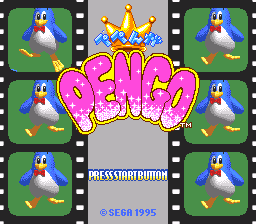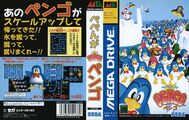Pepenga Pengo
From Sega Retro
| Pepenga Pengo(ぺぺんがPENGO) | ||||||||||
|---|---|---|---|---|---|---|---|---|---|---|
| System(s): Sega Mega Drive, Virtual Console | ||||||||||
| Publisher: Sega | ||||||||||
| Developer: Sega, JSH | ||||||||||
| Genre: Action | ||||||||||
| Number of players: 1-2 | ||||||||||
| ||||||||||
|
CERO
Missing Parameter! |
This short article is in need of work. You can help Sega Retro by adding to it.
Pepenga Pengo (ぺぺんがPENGO), sometimes just known as Pengo, is a sequel to the 1982 arcade game, Pengo. It was released for the Sega Mega Drive exclusively in Japan in 1995, and was the last first-party Sega Mega Drive game to be released in that region.
Gameplay
Pepenga Pengo differs significantly from the original Pengo and is now structured even more like a Bomberman game than its predecessor. The goal is the same as before - to defeat all enemies on screen, however the major difference is that Pengo can now create ice blocks to kick (with ![]() ). The rules have also changed regarding how blocks react with each other - pushing block A against block B will cause A to stop after impact, and B to continue the momentum. Placing three diamond blocks in a row will also destroy all enemies on screen, as opposed to just rewarding the player with a bonus.
). The rules have also changed regarding how blocks react with each other - pushing block A against block B will cause A to stop after impact, and B to continue the momentum. Placing three diamond blocks in a row will also destroy all enemies on screen, as opposed to just rewarding the player with a bonus.
Pengo can no longer smash ice blocks, however there are blocks that can be destroyed by kicking ice blocks into them. There is also an items system similar to Bomberman, affecting Pengo's speed and the amount of ice blocks he can create at one time. There is even a "battle mode" in which you can take on three other players. This idea would later be recycled with the 2010 arcade sequel, Pengo!.
Pepenga Pengo contains a port of the original game, though the music has been changed in this port to avoid potential legal issues (and is different to other ports of Pengo in this regard).
History
Legacy
Pepenga Pengo has never seen an international release, however was brought to the Japanese Wii Virtual Console service in 2009. This version was once rated by the ESRB for North America, suggesting the game was due to international markets, but western versions never materialised.
Production Credits
Planner: Eno "P"
Programmer: Work Ram "E", At‑At
Graphic Designer: Taro Arima, Namihei, Monty, Usi
Sound: Hiyodori Tome, Chikayo F.
Executive Producer: Mamoru Shigeta
Producer: Hiroshi Aso
Director: Takumi Yoshinaga
Special Thanks: Hideki Katagiri, Nobuo Matsusima
Physical Scans
| Sega Retro Average | |||||||||||||||||||
|---|---|---|---|---|---|---|---|---|---|---|---|---|---|---|---|---|---|---|---|
|
| 65 | |
|---|---|
| Based on 3 reviews | |
External links
<ref> tag; name ":File:MeanMachinesSega42UK.pdf_p84" defined multiple times with different content

